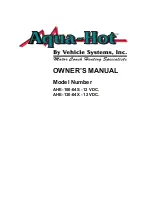
OPERATING INSTRUCTIONS
Before using the MILWAUKEE Lever Hoist, familiarize yourself
with all components of this hoist (See Functional Description).
Always check the hoist for proper operation before use. Under
no circumstances should you operate a malfunctioning hoist.
Test the operation of the hoist before operating at rated
capacity.
Operate the hoist with no load and then with a light load of
approximately 100 pounds (46Kg) to make sure it operates
properly and that the brake holds the load when the lever is
released.
FREE CHAINING
In this mode, the load chain can be pulled through the hoist in
either direction by hand for quick attachment to the load.
To set the hoist to free chaining mode
1. Remove any load from the hoist and move the directions
lever to the (“N”) position.
2. Turn the free chaining knob counterclockwise ( ) to
disengage the brake and pull on either chain until the lower
hook is at the desired position.
To reset the hoist for load operation
1. To Disengage the free chaining feature, move the directional
lever to the load (
) or unload position (
). Pull the load
chain in either direction to insure the unit is out of the free
chaining mode.
OPERATING THE LEVER HOIST
The MILWAUKEE Lever Hoist can be used in any position
provided it is rigged to pull in a straight line from hook to hook
(See Figure 2). The frame must always be free to swivel on the
upper hook.
To reduce the risk of injury, carefully check unit for
external damage prior to installation. Do not operate a
damaged or malfunctioning hoist. Do not operate a
hoist with a twisted, kinked, damaged or worn chain.
Operating a unit with obvious external damage may
cause load to drop resulting in personal injury and/or
property damage.
To reduce the risk of injury, do not lift people or loads
over people.
Do not lift more than the rated load.
Do not use load chain as a sling.
To reduce the risk of injury, never pull out or turn the
free chaining knob when the hoist is under load. Pulling
out or turning the free chaining knob with a load
attached will allow the load to release.
To reduce the risk of injury, rig the hoist in a straight
line hook to hook and keep the frame free to swivel.
If the frame is not free to swivel, the lever pull may
break the frame and cause physical injury and/or loss
of the load.
Do not allow the frame to touch the load or bear on
any support when in use. This may cause bending of
the hook or frame and cause possible failure.
Figure 1
Free
Chaining
Knob
Cam
Guide
Directional Lever
CORRECT
INCORRECT
Sling
Upper and
lower hooks
in straight
line. Frame
is free to
swivel.
Load
SAFE PULLING ANGLE
DANGEROUS PULLING
ANGLE
Load
Not a
straight line
between
upper and
lower hooks.
Frame is not
free to swivel.
Figure 2
OPERATION




































